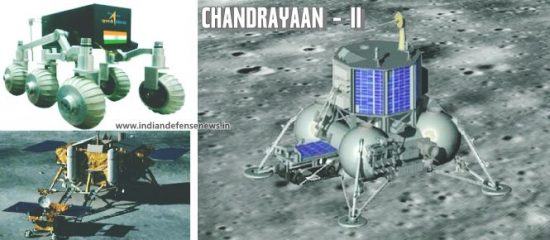June 27, 2018 – ISRO, the Indian space agency, plans to go to the Moon in October of this year, land a rover, and have it analyze the lunar regolith for what could be a trillion dollar opportunity. The lunar target is the south side of the Moon where the rover will sample the surface for both water and Helium-3. Finding water would allow future lunar missions in which humans participate, a source of oxygen and hydrogen fuel, let alone the liquid itself. But the money-making enterprise would be in the mining of Helium-3 which on Earth today can only be produced in any quantity in existing nuclear fission reactors. On the Moon, however, the stuff is right there on the surface to be scraped up and potentially returned to Earth where it could fuel the energy requirements of the planet for 250 years.
This will not be ISRO’s first lunar landing mission. Chandrayaan-1, launched in 2008, included an orbiter and probe which descended to the surface to detect the presence of water molecules. The October mission, Chandrayaan-2, is to include an orbiter, lander, and solar-powered rover. The plan is for a surface mission lasting 14 days with the rover covering a 400-meter (1,300 feet) radius. The rover will gather evidence of existing surface deposits of Helium-3 which naturally collects on the Moon’s surface as the solar wind strikes it.
Helium-3 today is being used in experimental fusion reactors. The isotope is not radioactive. And the moon NASA estimates has in excess of 1 million tons of the stuff valued at $5 billion per ton. If India and other space operations can harvest even a quarter of the Moon’s Helium-3 it could help provide clean nuclear fusion power to the entire Earth for up to the next five centuries.
India hopes to be the first into this lucrative opportunity. There are many obstacles to be overcome on the way to making this commercially viable. Mining Helium-3 is just one step in a very complex logistical supply chain. ISRO will have to develop a space infrastructure that can get the Helium-3 from the lunar surface to Earth. As of yet, no country or commercial space venture has put together such an operation.
Although the nations of the world have been governed since the 1960s by an international treaty that prohibits the commercial exploitation of space, it appears that keeping to this promise is getting harder to do. Two nations, the United States, and Luxembourg have both legislated the right of commercial entities to mine asteroids and other space bodies. India will probably soon enact legislation of its own to give legality to its ambitious plans.
Rakesh Sharma, who flew on board a Russian spacecraft back in 1984, is quoted in an article in The Times of India, stating: “You can’t go to the Moon and draw boundaries…..I want India to show that we’re capable of utilizing space technology for the good of people.”
Doing space missions on a small budget is turning out to be India’s thing. The country spends about $1.7 billion annually on national space projects which include two made-in-India rockets launching numerous satellites including telecommunications, global positioning systems, and scientific payloads. India is even competing with SpaceX in the space launch business these days. The country sent an orbiter to Mars on the first try (something the Soviet Union couldn’t do) and did it on the cheap. The upcoming lunar mission is expected to cost $125 million.
















